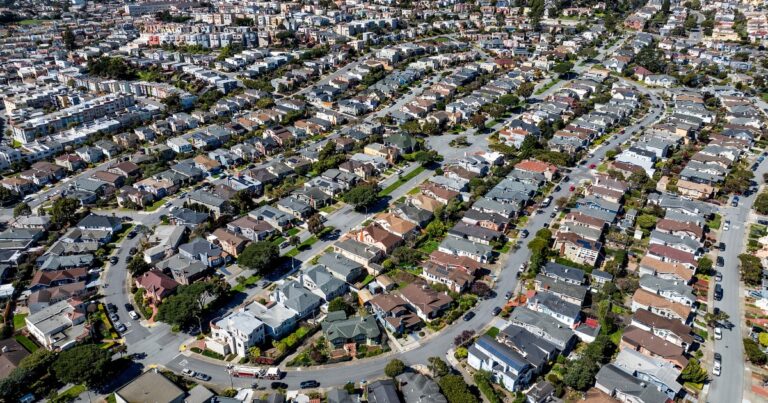San Francisco Real Estate: A Unique Case in the U.S. Housing Market
San Francisco has emerged as an interesting anomaly in the current U.S. housing market landscape. According to data compiled by Zillow, it is the only major city in the United States where home prices have depreciated over the past five years. This distinct trend has raised questions and piqued interest among homebuyers, economists, and real estate professionals alike. As the country’s housing market continues to experience rising home prices, San Francisco’s situation presents a compelling case study in the complexities of real estate dynamics.
Breaking Down the Data
The data from Zillow’s “Zillow Price Index” illustrates a striking comparison. From November 2019 to November 2024, typical home prices in San Francisco dropped by 3.7%, making it the only city among the top 100 most populous urban areas in the U.S. to see such a decline. In stark contrast, numerous cities across the nation clocked significant increases in home prices during this same period. For instance, Los Angeles experienced a rise of 37.58%, while Austin saw an increase of 38.34%. Miami topped the list with an astounding 69.26% rise in home prices, emphasizing how divergent San Francisco’s market has become.
The Big Question: Is It Really Cheap?
While the distinction of being cheaper to buy a home now than it was five years ago might suggest an affordable market, the reality is more nuanced. Zillow reports that the typical home price in San Francisco in November 2024 stood at approximately $1.26 million, a slight decrease from $1.31 million five years prior. Although this does indicate a downward trend, it’s important to recognize that such figures still place San Francisco among the most expensive cities in the nation. In fact, five years ago, its home prices were over 30% higher than those of the second-most expensive city, San Jose.
Context of California’s Housing Market
In 2024, San Francisco was one of only four cities in California boasting a typical home price above the $1 million mark. This number accentuates the city’s ongoing high cost of living, despite the slight drop in home prices. The reality is that buyers in San Francisco still face challenges associated with sky-high property values, making it difficult for many potential homeowners to enter the market.
The Changing Demographics of Homebuyers
The shifts in home prices and buying trends can be attributed, in part, to the pandemic’s effect on how people work and live. Kara Ng, a senior economist at Zillow, explains that San Francisco’s unique position comes from the city’s historical reputation as the most expensive place to purchase a home in the United States. However, the pandemic has led to a migration of high-wage earners who are now constrained by these exorbitant property prices. Many are seeking alternative locations that offer a more affordable housing market while still providing access to necessary amenities, jobs, and lifestyle conveniences.
Implications for Future Trends
As we look ahead, it will be essential to monitor how San Francisco’s market evolves. With the potential for further changes in work habits, remote opportunities, and urban migration patterns, the dynamics of homebuyer preferences may continue to shift. Moreover, the economic landscape is constantly changing, influenced by interest rates, local policies, and housing supply, all of which can impact pricing trends in the city.
Conclusion
San Francisco’s housing market presents a unique case amid the rising costs seen in other major cities across the United States. While properties have become less expensive compared to five years ago, the high price tags still present significant challenges for many prospective buyers. The ongoing economic and demographic shifts, particularly in the wake of the pandemic, will continue to shape the real estate landscape. Therefore, understanding San Francisco’s market requires a comprehensive consideration of current trends, buyer preferences, and broader economic factors.
FAQs
1. Why are home prices in San Francisco lower compared to other major cities?
Several factors contribute to the decrease in home prices in San Francisco, including the migration of high-wage earners seeking affordable housing and the impacts of the pandemic. Distinct socioeconomic trends and demographic shifts also play key roles in this phenomenon.
2. Is it a good time to buy a home in San Francisco?
While home prices might be lower than they were five years ago, they remain considerably high. Time will tell whether the trend will continue or reverse, but potential buyers should consider their financial circumstances and market conditions before making a decision.
3. What are the other California cities with home prices above $1 million?
In 2024, alongside San Francisco, other California cities with typical home prices above $1 million include Los Angeles, San Diego, and San Jose, reflecting similar trends of high property values across the state.
4. How does the Zillow Price Index calculate home values?
The Zillow Price Index aggregates data from various real estate listings and sales, evaluating trends in home values over specified timeframes. This index provides valuable insights for analyzing changes in housing markets across different regions.
5. What consequences do declining home prices have on the local economy?
Declining home prices can have mixed effects on a local economy. While it may improve affordability for buyers, it could also lead to reduced property tax revenues, affecting public services and overall economic growth. Additionally, homeowner equity may diminish, impacting spending patterns.



